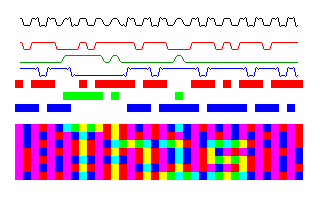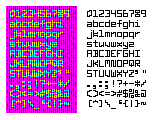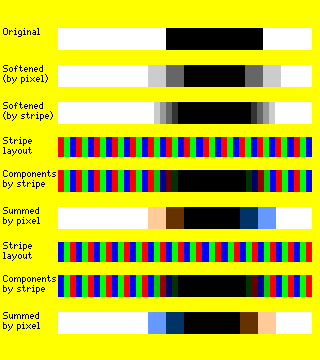
Originally, encryption was carried out using pencil and paper. Some cipher machines, such as the Enigma and the desktop Hagelin lug and pin machines, had lockable cabinets. This meant that the machines could be operated by someone who, not having the key, could not directly access either the rotor wirings or the alphabet ring settings of the Enigma, or the lug and pin settings of a Hagelin machine.
Today, with microprocessor-based devices being used for encryption, it is possible to take measures of this type further.
Among the measures it is possible to take with dedicated cryptographic hardware are the following:
Another advantage of special-purpose hardware is that one element missing from the desktop PC can be added; a hardware source of true random numbers.
Whether one is using a desktop PC or a specialized device, another problem inherent in using electronics, particularly microprocessors, to encipher a message is that the high-frequency pulses used to carry information from one part of a computer to another can also travel through the air as radio signals. Surrounding a device with solid metal shielding is one preventive measure, and some high-security devices may even use a masking noise signal as well. Unless one is using battery power, there need to be some insulating breaks in any metal shielding used. Their permissible size would be determined by the highest frequency of the radiation that one is concerned about having leak out. In this connection, it might be noted that square waves have quite a bit of high odd-harmonic content.
Normally, when a home PC is used for encryption, the result of the encryption process is a disk file, which is transmitted later, so any electronic leakage is in the form of unwanted radiation from the computer at the time of encryption. If one is dealing with special-purpose encryption hardware, however, the output may be an actual electrical signal which is fed to a radio transmitter or a telephone line. In that case, it is necessary to be concerned with electrical leakage within the device from wires carrying the signal containing the plaintext to wires carrying the signal containing the ciphertext.
To prevent this, precautions are taken which are sometimes termed "red/black separation". The portion of a device that handles the plaintext is termed red, and the portion that contains only signals which may be sent to the outside world is termed black. This is accomplished through separating functions on different circuit boards, using shielding within the device to isolate its separate parts.
When a high level of security is required, since at least when the ciphertext is first generated, it is generated inside a chip that gets plaintext as input, the possibly contaminated ciphertext signal can be routed to a shielded area containing a circuit that re-generates the plaintext waveform, with its own clean clock signal and so on.
Analogous techniques are used to separate the digital and analog areas of high-quality CD players.
I have recently heard of an idea called "software TEMPEST". The paper by Markus Kuhn and Ross Anderson deals with this topic in a sophisticated fashion, but I present here a much more simplistic scheme that may also already be offered for use by someone out there. While the simplistic scheme allows small characters and the use of a limited number of colors, it is not something I take too seriously. While measures of this sort cannot completely prevent electromagnetic eavesdropping, as they do weaken the easiest method of exploiting such leakage, they might still be as effective as any simple measure that ordinary computer users are likely to take.
Given that the typical PC uses a monitor with independent signals for Red, Green, and Blue, rather than a monitor recieving a composite signal for CGA, it is difficult for an eavesdropper to distinguish between the three colors. However, visually, green is much brighter than blue, and red, although slightly brighter than blue, is also not as bright as green.
This can be used to permit text to be displayed like this:

This diagram illustrates both what this scheme is supposed to achieve, and how it may fall short: the Red, Green, and Blue signals are shown as waveforms, and their sum, although it is a square wave varying between one signal and two, and even spikes due to signals crossing with slight time discrepancies are avoided, would still betray the text on the screen because of real-world variations between the three electron guns in a CRT. This is shown in the diagram in a very simplified form; a stray inductance causes ringing in the blue signal, while too much capacitance to ground smears the green signal.
A truly determined eavesdropper has the options to listen to other signals from your computer, as well as finding small differences in timing or level between the three color signals, or even exploiting the fact that the three electron guns in a CRT are physically displaced from one another.
To avoid leaking any useful information at all, subject to the assumption that the eavesdropper cannot distinguish between the Red, Green, and Blue signals these rules are followed in producing text like this:
This requires that the text characters always begin and end on an odd pixel; this can even be done with a 5 by 7 font, provided one allows it to have a chunky, squarish appearance.
The intent of these rules is to ensure that, between any two pixels, there is always exactly one of the three additive primaries, Red, Green, or Blue, that changes between on and off, and furthermore, that the change always alternates between on and off, two being on for every odd pixel, and one being on for every even pixel.
Here is an illustration of the kind of alphabet required, as well as a sample of the appearance of this kind of text when it is not enlarged, to show that it can actually be sort of readable.

And, since web pages are viewed at higher resolutions than is consistent with the normal use of a 5 by 7 font, here is the same illustration at double size:

which gives a more accurate illustration of how such text might appear in actual use, on the type of low-resolution eight-color display to which it is suited.
The "software TEMPEST" technology and fonts of Kuhn and Anderson, for which they hold a patent, involves fonts that are far less bizarre, perhaps looking somewhat like this:

Their paper also notes that an early proposal for something
similar took advantage of the fact that early video displays
needed to return to black after each pixel to prevent blooming,
and so I suppose that would have allowed one to get away with
using a font that looked
![]() .
.
Incidentally, my design for a strange font can be used to provide a fairly transparent security against another form of interception with a small change: if one exchanges the roles of the red and green components of the image, the text is no longer readable normally, but becomes quite legible when viewed with a red filter:


and, of course, techniques for producing altered text with this property are quite old, having been used in merchandising contests, children's games, and even for programmed instruction.
It might also be noted while this variant would also provide the same limited protection against RF interception from a CRT as my original variation, neither would be useful for that purpose on a laptop, where the second version is most useful against casual eavesdropping, since laptop displays go through the colors in sequence instead of simultaneously. The principle of Kuhn and Anderson, on the other hand, can be used with laptops, but the font needs to be designed for the particular ordering of red, green, and blue stripes used in a given laptop. The principle required for a laptop, or other LCD display, is illustrated below:

Of course, sometimes the problem of having electrical emissions or other information about your enciphering being monitored cannot be solved. An illustration of a way to deal with this difficult circumstance is provided, although it may not be a practical one.